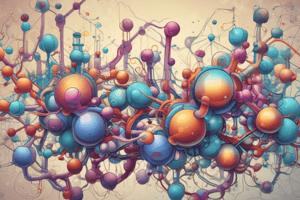Podcast
Questions and Answers
Which type of linkage does the amide-bearing side chain of asparagine form with oligosaccharide units in glycoproteins?
Which type of linkage does the amide-bearing side chain of asparagine form with oligosaccharide units in glycoproteins?
- Disulfide linkage
- Ester linkage
- Peptide linkage
- Glycosidic linkage (correct)
What is the main reason for the ultraviolet absorption of most proteins in the 275-285 nm range?
What is the main reason for the ultraviolet absorption of most proteins in the 275-285 nm range?
- Sulfur-containing amino acids
- Presence of histidine
- Tryptophan content (correct)
- Aliphatic side chains
In proteins, which group is subject to phosphorylation in some enzymes for the regulation of metabolic pathways?
In proteins, which group is subject to phosphorylation in some enzymes for the regulation of metabolic pathways?
- Cyclic pyrrolidine group of proline
- Hydroxyl group of tyrosine (correct)
- Butylammonium side chain of lysine
- Imidazole group of histidine
Which ionizable group enables amino acids to act as both acids and bases?
Which ionizable group enables amino acids to act as both acids and bases?
What effect does the imidazole group of histidine have on the buffering activities of proteins?
What effect does the imidazole group of histidine have on the buffering activities of proteins?
What is the role of the butylammonium side chain of lysine in proteins?
What is the role of the butylammonium side chain of lysine in proteins?
Which side chain introduces a bend in the peptide chain?
Which side chain introduces a bend in the peptide chain?
What is the primary form of interaction between reducing ends of oligosaccharides and serine/threonine residues?
What is the primary form of interaction between reducing ends of oligosaccharides and serine/threonine residues?
How does tryptophan absorption at 280 nm help indirectly measure protein concentration?
How does tryptophan absorption at 280 nm help indirectly measure protein concentration?
What makes an amino acid an amphoteric substance?
What makes an amino acid an amphoteric substance?
Flashcards are hidden until you start studying
Study Notes
Stereochemistry of Amino Acids
- The α-carbon of amino acids has four different groups attached, making it a chiral or asymmetric carbon, resulting in two possible enantiomers (L and D) that are non-superimposable mirror images and optically active
- Nearly all amino acids occurring in proteins are of the L-form, while D-amino acids are rare in nature
- Glycine is the only amino acid that lacks a mirror image pair of enantiomers and is not optically active
Classification of Amino Acids
- The 20 amino acids in proteins are encoded by DNA and can be designated by a three-letter abbreviation
- Classification schemes include polarity and charge on R groups, structure of side chains, catabolic fate of the amino acid, and the body’s ability to synthesize the amino acid
Classification based on Polarity and Charge on R Groups
- Amino acids are classified into three subgroups based on polarity and charge on their R groups
- Non-polar R Groups: eight amino acids with non-polar side chains, including alanine, valine, leucine, isoleucine, methionine, proline, phenylalanine, and tryptophan
- Uncharged Polar R Groups: amino acids with uncharged, polar side chains, including serine, threonine, glycine, asparagine, glutamine, and tyrosine
- Charged Polar R Groups: five amino acids with charged side chains, including lysine, arginine, histidine, glutamic acid, and aspartic acid
Classification based on Structure of Side Chain
- Aliphatic amino acids: branched chain amino acids (valine, leucine, isoleucine), sulphur-containing amino acids (methionine, cysteine), amide group-containing amino acids (asparagine, glutamine), hydroxy amino acids (serine, threonine, tyrosine), and simple amino acids (glycine and alanine)
- Aromatic amino acids: phenylalanine, tyrosine, and tryptophan
- Imino acid: proline
- Heterocyclic amino acids: histidine and tryptophan
- Dicarboxylic amino acids: aspartic acid and glutamic acid
Classification based on Catabolic Fate of Amino Acid
- Amino acids can be divided into three categories based on their catabolic fate: glucogenic, ketogenic, and those that can give rise to both glucose and ketone bodies
Studying That Suits You
Use AI to generate personalized quizzes and flashcards to suit your learning preferences.



